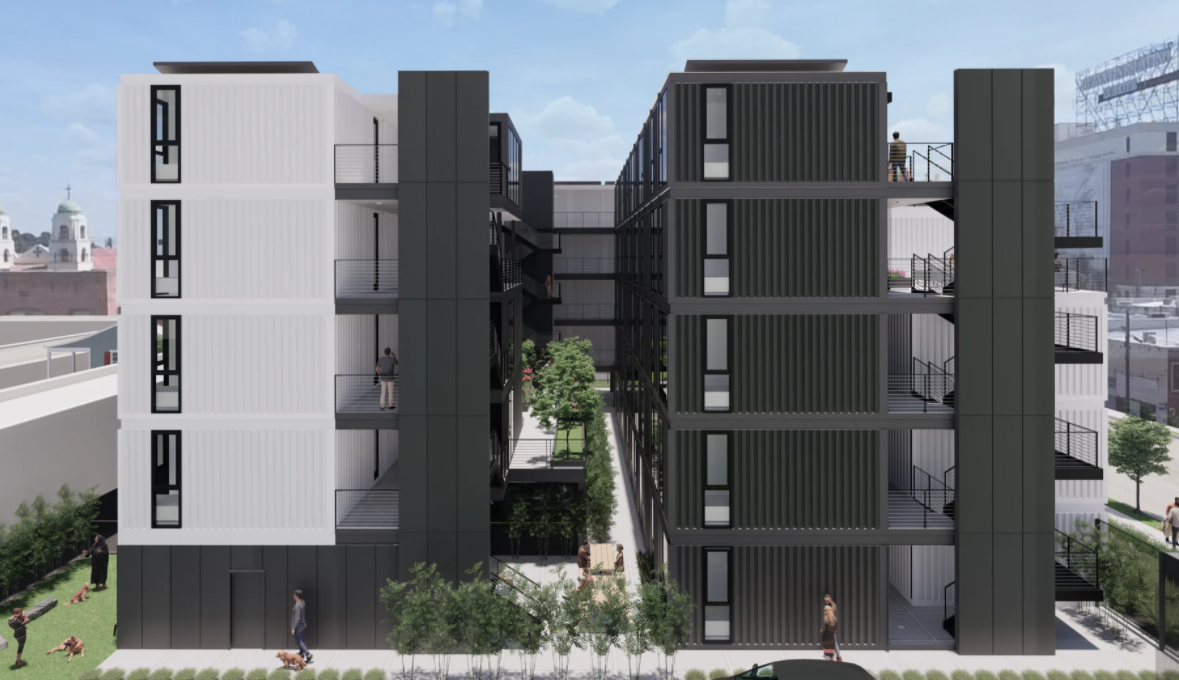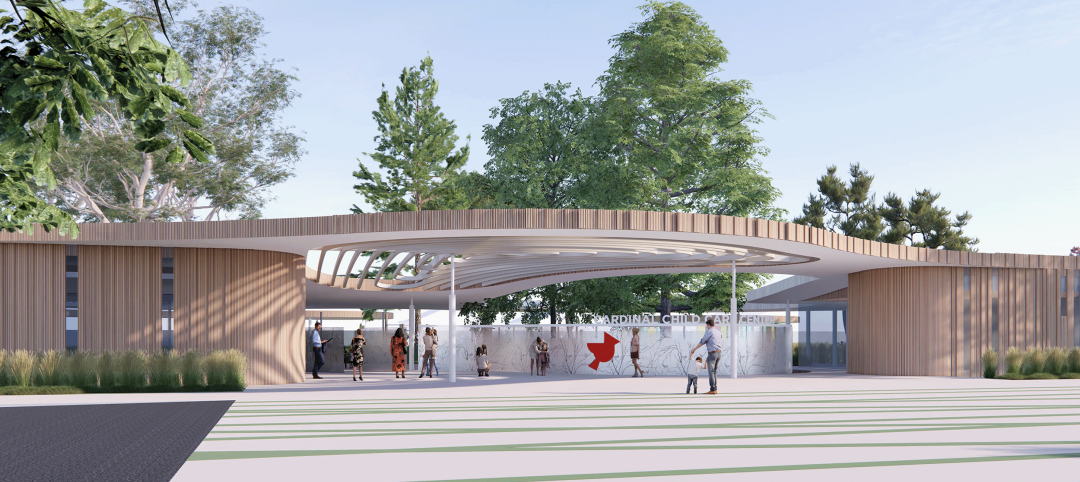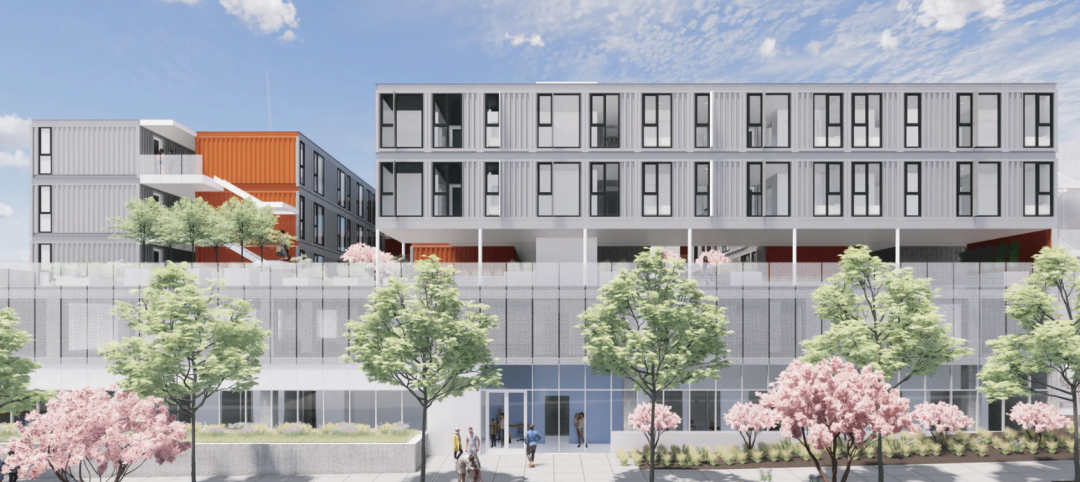Every young child engrossed in building blocks and construction toys will eventually upgrade, moving from bulky bricks to more diverse, nimble Legos to develop ever-more-detailed, expressive systems of preadolescent architecture. In the adult world of urban development, developers and designers are undergoing a similar shift, as modular construction — a building system utilizing pre-assembled pieces made off-site, often in factories — becomes faster and more cost-effective than traditional techniques.
“The modular industry is finding its place in the market, and that is leading to more expressive architecture, complexity and sophistication,” says Matthew Porreca, Design Director at LPA. “The wider adoption of these methods is like the technological revolution that took place two decades ago, when architects and builders moved from paper plans to digital models.”
For developers, the rising cost of traditional construction is intersecting with the shrinking cost of modular, making the latter more appealing than ever. Modular construction is expected to grow into a $130-billion market in the United States and Europe by 2030, according to a 2019 study by McKinsey & Co. (Another analysis, by Reports and Data, suggests that the global market will expand to $192 billion from roughly $120 billion between 2019 and 2027.) A new generation of efficient, high-quality, systematized approaches can save money, cut construction times and encourage creativity, says LPA Director of Mixed-use Matt Winter, who has used modular construction in projects including retail, office and housing.
Winter sees no tradeoff between pre-built, off-site construction and the goal of designing great places that focus on the neighborhood context.
“In many senses, modularity allows us to focus more on the design, orientation and neighborhood characteristics,” he says. “It gives us the flexibility to make sure each of these projects is unique, not just a formulaic expression.”
THE TIME IS RIGHT FOR MODULAR
The basic concepts of modular design are not new. Prefabrication and template systems have been hailed for decades as a solution to inefficiencies, drawn-out timelines and rising construction costs. Even Frank Lloyd Wright in the rush to make midcentury home building as dependable as an assembly line.
But modular has never lived up to its potential. Quality-control problems, labor issues and lack of creative design have hindered the industry and prevented widespread adoption.
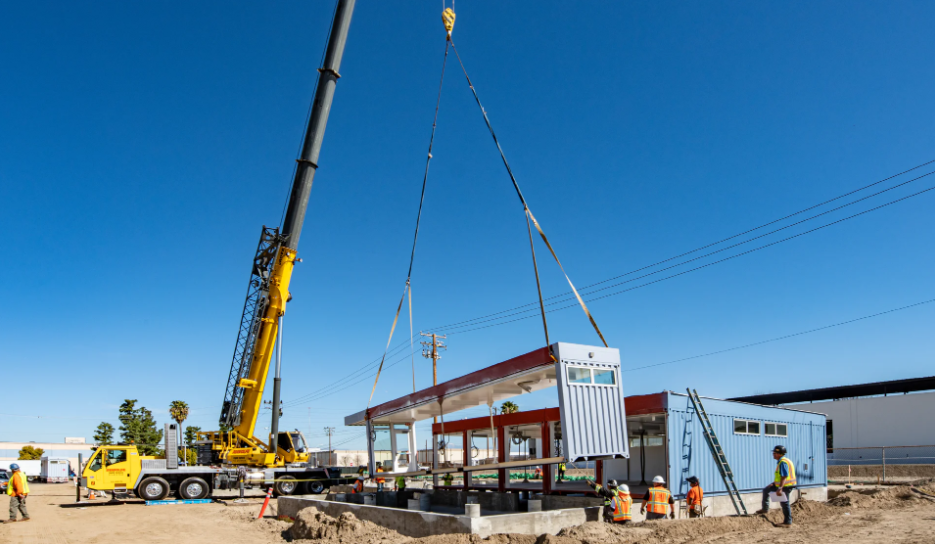 For the Buena Vista Navigation Center, the modular units were created off-site and assembled in a few days. Photo courtesy LPA Inc.
For the Buena Vista Navigation Center, the modular units were created off-site and assembled in a few days. Photo courtesy LPA Inc.
Today, modular development could finally be ready for its moment. Improvements in building technology and shifts in building codes and regulations have helped make the vision of a more precise, manufactured and innovative building system a reality. As a result, there is a new global boom in modular construction, spearheaded in the United States by a constellation of companies on the West Coast, including CRATE Modular and Factory OS.
In many ways, the growth of modular construction is almost a vernacular response to the rising costs that define construction in markets from San Diego to Seattle. In the Bay Area alone, costs for the traditional developer-architect-contractor building model shot up 30 percent between 2015 and 2018, according to an industry report. In 2018, with affordable housing at $750,000 a unit, San Francisco Mayor London Breed pledged that the city would spend $100 million on modular housing.
The finances of modular make sense. Modular design can knock as much as 20 percent off the cost of many projects, according to a 2017 analysis by AECOM, an infrastructure consulting firm. As the “hard costs” of construction, such as labor, land and materials, continue to rise, modular can slash construction times and get income-generating properties up and running much more quickly. Walls can be made in a factory as the foundation is poured. Factory-made walls can be inspected and approved more quickly. Some companies offer customizable walls with pre-installed electric lines, lights and even appliances.
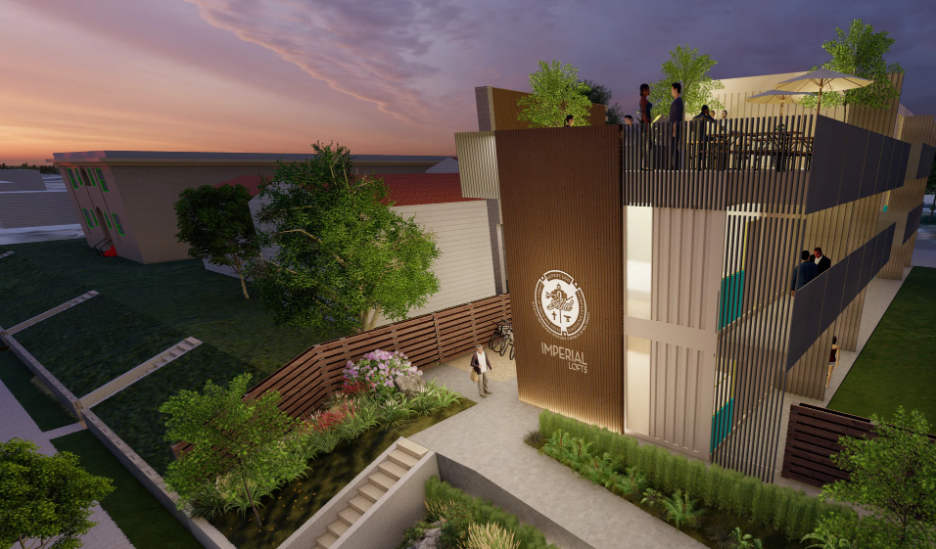 The design of a supportive housing complex for Bethel AME Church in San Diego, California, moves beyond the typical blocky façade by including open spaces, a brise soleil and rooftop deck. Courtesy LPA Inc.
The design of a supportive housing complex for Bethel AME Church in San Diego, California, moves beyond the typical blocky façade by including open spaces, a brise soleil and rooftop deck. Courtesy LPA Inc.
Everything about the process creates efficiency. Prebuilt apartment units can be trucked onto the building site, cutting regulatory red tape and labor costs. Some design firms have estimated that the build time for a multifamily project is cut in half with modular, while the McKinsey study found a “solid track record” of modular construction sites accelerating project timelines by 20 to 50 percent.
“The savings isn’t in the cost of construction; it’s the speed to market,” says Winter. “It makes a big difference when you can deliver something in seven months instead of 14 months.”
1: Photovoltaic System - The entire roof area was preserved to maximize the space for the PV system to generate energy for the complex.
2: Shade Courtyard - The central courtyard provides a shaded retreat with natural airflows.
3: Passive Ventilation - Vertical casement windows in each of the units promote passive ventilation airflows.
4: Natural Daylight - Full height windows bring light deep into every apartment and provide views to the neighborhood.
5: Active Exterior Circulation - The open circulation is organized horizontally and vertically, encouraging health and wellness.
6: Vegetated Roof Deck - The project is organized to create an upper roof deck with a community vegetable garden.
7: Biofiltration Basin - A biofiltration system treats and stores water collected on-site, while promoting biodiversity. The integration of landscape connects people with nature to promote health and wellness.
8: High-Efficiency VRF HVAC - A centralized VRF system and heat pump boiler system reduce overall energy use. The systems are located on the ground level to preserve the roof area for the PV system.
9: Sunshades Vertical - Sunshades wrap around the exterior of the building, providing shade and reflecting light into homes.
10: Recycled Shipping Containers - The design employs single-use, recycled shipping containers, which are repurposed off-site as prefabricated modular units.
AN OPPORTUNITY FOR INNOVATION
Modular systems are perfect for cities, infill projects and small lots where increased density can make a project work, Winter says. As modular construction firms evolve to become more efficient and detailed with their end products, they’re growing beyond the tired aesthetic stereotypes that led critics to dismiss the concept as nothing more than blocky forms and façades reminiscent of Minecraft. New approaches can challenge the idea that modular always means boxy, bland and formulaic, Winter says.
A number of recent LPA projects found creative solutions by playing with, not against, the rectangular forms of shipping container construction. The efficiency of the modular systems allows for different uses and new ideas. An upcoming project for the Bethel AME Church in San Diego uses a series of stacked, prebuilt cubes to form a streamlined supportive housing complex with a brise soleil and a rooftop deck. For another 21-unit mixed-use development in San Diego, a combination retail and residential project fashioned from recycled shipping containers is wrapped in vibrant murals reflecting the surrounding Barrio Logan neighborhood.
“Good designers thrive within budgets and constraints; it’s the idea that you can’t play tennis without the net,” Winter says.
Modular isn’t limited in scope, either. In San Diego, the Family Health Center, the region’s largest, will redevelop a surface parking lot into City Heights Housing, an eight-story, mixed-use community center with a five-story podium, behavioral health clinic and 170 units of housing, all set to be assembled from shipping containers. A 52-unit project across town near Balboa Park will use manufactured, steel-framed units as part of a creative infill project wedged into a constrained lot. When completed, the two projects will be among the biggest modular builds in San Diego.
Even as modular becomes more widespread, some hurdles remain. Winter points to banking and financing — modular builds require more upfront investment because of the quicker assembly — as well as regulatory barriers and antiquated building codes as additional weights holding down new projects. But signs of acceptance are on the rise. Cities are streamlining inspections, checking more builds in the factory and off-site and updating regulations. San Diego plans to introduce a modular section to its building code next year.
The industry is also benefiting from the familiarity that comes with using different modular systems with different contractors. LPA has made big strides in creating best practices and project management tools to organize and better track the modular process, while explaining everyone’s “role in the ballet.”
“There’s a huge design opportunity in modular housing to really do something better, especially when so much can be limited by cost,” Porreca says. “What better design challenge than reimagining areas that often aren’t served as well as they should be?”
More from Author
LPA | Aug 26, 2024
Windows in K-12 classrooms provide opportunities, not distractions
On a knee-jerk level, a window seems like a built-in distraction, guaranteed to promote wandering minds in any classroom or workspace. Yet, a steady stream of studies has found the opposite to be true.
LPA | May 13, 2024
S.M.A.R.T. campus combines 3 schools on one site
From the start of the design process for Santa Clara Unified School District’s new preK-12 campus, discussions moved beyond brick-and-mortar to focus on envisioning the future of education in Silicon Valley.
LPA | Mar 28, 2024
Workplace campus design philosophy: People are the new amenity
Nick Arambarri, AIA, LEED AP BD+C, NCARB, Director of Commercial, LPA, underscores the value of providing rich, human-focused environments for the return-to-office workforce.
LPA | Feb 8, 2024
LPA President Dan Heinfeld announced retirement
LPA Design Studios announced the upcoming retirement of longtime president Dan Heinfeld, who led the firm’s growth from a small, commercial development-focused architecture studio into a nation-leading integrated design practice setting new standards for performance and design excellence.
LPA | Mar 2, 2023
The next steps for a sustainable, decarbonized future
For building owners and developers, the push to net zero energy and carbon neutrality is no longer an academic discussion.
LPA | Dec 20, 2022
Designing an inspiring, net zero early childhood learning center
LPA's design for a new learning center in San Bernardino provides a model for a facility that prepares children for learning and supports the community.
LPA | Aug 22, 2022
Less bad is no longer good enough
As we enter the next phase of our fight against climate change, I am cautiously optimistic about our sustainable future and the design industry’s ability to affect what the American Institute of Architects (AIA) calls the biggest challenge of our generation.
LPA | Aug 9, 2022
Designing healthy learning environments
Studies confirm healthy environments can improve learning outcomes and student success.
LPA | Jul 6, 2022
The power of contextual housing development
Creating urban villages and vibrant communities starts with a better understanding of place, writes LPA's Matthew Porreca.
LPA | Mar 21, 2022
Finding the ROI for biophilic design
It takes more than big windows and a few plants to create an effective biophilic design.

